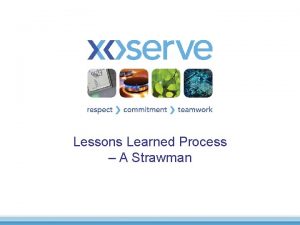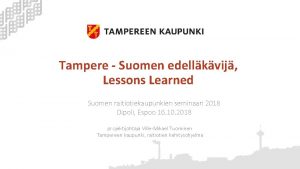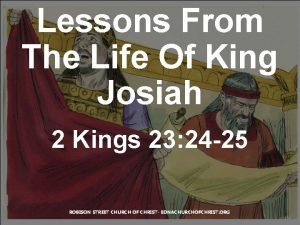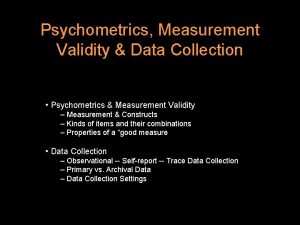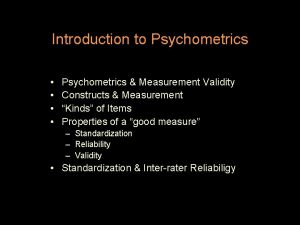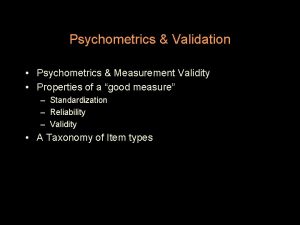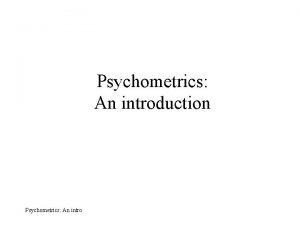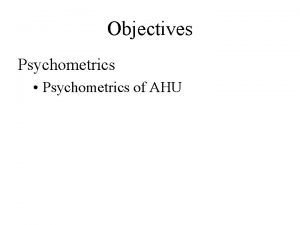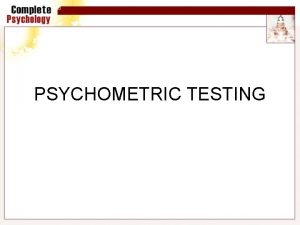The psychometrics of Likert surveys Lessons learned from














- Slides: 14

The psychometrics of Likert surveys: Lessons learned from analyses of the 16 pf Questionnaire Alan D. Mead

Measures are just measures, right? �One measurement theory (CTT or IRT or g theory, etc. ) for all types of measures �I thought so, before I started teaching at IIT �But the “devil’s in the details” and these details vary considerably “Getting started” and Item writing Item analysis Implementation �I will use the 16 pf as an example; most of these points are true for all Likert instruments


16 pf 6 Planned Improvements �Shorter, more reliable Likert scales �Adaptive Reasoning/B scale �Improved inattention validity index �Updated norms �Measuring the same factor structure as 16 pf 5 �Gender neutral reports �Even better support for organizational applications

Everything we know about writing personality/Likert items Get it? This page is BLANK! (Funny joke, but not actually a laughing matter!)

Seriously, what we know about writing personality/Likert items � Most item writing guidance is (explicitly) designed for ability testing: Rule 1: Use either the best answer format or the correct answer format Rule 11: Avoid cuing one item with another; keep items independent of one another � Many guidelines are trivial/common sense Rule 4: Allow time for editing and other types of item revisions Rule 5: Use good grammar, punctuation, and spelling � Some guidelines are bad advice � Finally, a very few guidelines actually apply � Existing guidance either ignores Likert-specific issues…

Seriously, what we know about writing personality/Likert items � Most item writing guidance is (explicitly) designed for ability testing: � Many guidelines are trivial/common sense � Some guidelines are bad advice Rule 22: Word the stem positively; avoid negative phrasing. � Finally, a very few guidelines actually apply Rule 35: Avoid specific determiners, such as “never” and “always” � Existing guidance either ignores Likert-specific issues or is based on weak empiricism (“So-and-so found that 4 -options scales were optimal [by some unstated criteria], so use those. ”)

Scoring and Item Analysis �Generally, Likert items have “directions” rather than correct answers �Consider these Emotional Stability items: “I rarely feel blue” (positively worded) “I have days where I just cannot cope. ” (negatively worded) �The “direction” would be reversed for Neuroticism These “are” both Emotional Stability and Neuroticism items

Scoring and Item Analysis (cont. ) �Several unique aspects of item analysis Item mean is not very important Corrected item-total correlation (CITC) is critical CITC should be greater than cross-scale correlations Factor analysis (item loading) may be important Greater concern about item homogeneity �Scales tend to be far shorter (3 items!? !) But individual items are informative But may preclude analyses requiring long scales

IRT Analysis �Much greater variety of statistical models Linear models (SEM) and non-linear models (IRT) Various ordinal models (GRM, GPCM) Nominal polytomous models (Nominal model) Multidimensional models Ideal-point models (above are all dominance models) �Calibration issues Larger N required for polytomous models Some response options cannot be fit Short scales preclude asymptotic chi-square tests of fit

IRT Analysis (cont. ) �Items have far greater Information Which increases with more response points (to some limit) �Perversely, Information is less important Item have wide Information �Less motivation to use “IRT scoring” Item “difficulty” not a significant issue CTT Likert scoring is generally good enough Short scales may damage theta-hat estimates

Administration �Traditional CAT has far less value MCAT makes more sense Strong preference for multiple items/screen �More formatting choices Traditional horizontal “scale” format; Vertical Technologically enhanced formats like sliders �Choice of response scales How many points? (4 -7? ) Include a midpoint? Forced-choice (“team player” or “talkative”? ) Choice of anchors (agreement, frequency, etc. )

Usage and Validity �Reporting issues �“Score security” (differing threats) �Effects of bi-polarity �Validity Greater care must be taken to ensure content validity Criterion-related validities are modest Construct validity may be more important

Thank You! Questions? amead@alanmead. org
 Lessons learned repository
Lessons learned repository Lesson learned register
Lesson learned register Leadership lessons from ants
Leadership lessons from ants Claremont workday
Claremont workday 1 kings 18 lesson
1 kings 18 lesson Lessons learned purpose
Lessons learned purpose Lessons learned suomeksi
Lessons learned suomeksi Six sigma lessons learned
Six sigma lessons learned Lessons learned faa
Lessons learned faa Life lessons from life of pi
Life lessons from life of pi Elijah contest at mount carmel
Elijah contest at mount carmel Is josiah luke a dwarf
Is josiah luke a dwarf Typhoon yolanda lessons learned
Typhoon yolanda lessons learned Hyatt regency bridge collapse
Hyatt regency bridge collapse Nerc lessons learned
Nerc lessons learned





